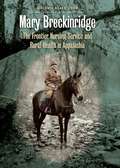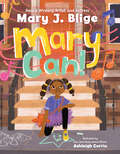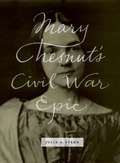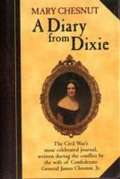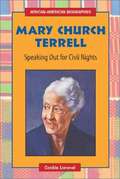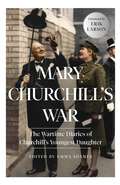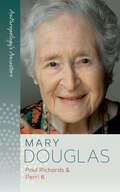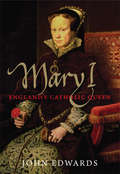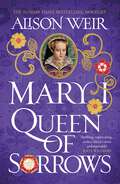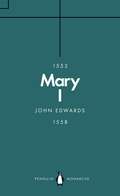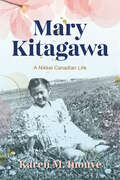- Table View
- List View
Mary Anning: The Girl Who Cracked Open The World
by Debora PearsonAs a young girl, Mary Anning loved to hunt for fossils by the sea. She wondered whether these rock creatures had ever been alive and resolved to learn all she could about what she found. As her discoveries became larger and more unusual, she earned the respect of scientists far and wide and changed the way we study Earth's history forever.
Mary Astor's Purple Diary: The Great American Sex Scandal of 1936
by Edward SorelIn a hilarious send-up of sex, scandal, and the Golden Age of Hollywood, legendary cartoonist Edward Sorel brings us a story (literally) ripped from the headlines of a bygone era. In 1965, a young, up-and-coming illustrator by the name of Edward Sorel was living in a $97-a-month railroad flat on Manhattan's Upper East Side. Resolved to fix up the place, Sorel began pulling up the linoleum on his kitchen floor, tearing away layer after layer until he discovered a hidden treasure: issues of the New York Daily News and Daily Mirror from 1936, each ablaze with a scandalous child custody trial taking place in Hollywood and starring the actress Mary Astor. Sorel forgot about his kitchen and lost himself in the story that had pushed Hitler and Franco off the front pages. At the time of the trial, Mary Astor was still only a supporting player in movies, but enough of a star to make headlines when it came out that George S. Kaufman, then the most successful playwright on Broadway and a married man to boot, had been her lover. The scandal revolved around Mary's diary, which her ex-husband, Dr. Franklyn Thorpe, had found when they were still together. Its incriminating contents had forced Mary to give up custody of their daughter in order to obtain a divorce. By 1936 she had decided to challenge the arrangement, even though Thorpe planned to use the diary to prove she was an unfit mother. Mary, he claimed, had not only kept a tally of all her extramarital affairs but graded them--and he'd already alerted the press. Enraptured by this sensational case and the actress at the heart of it, Sorel began a life-long obsession that now reaches its apex. Featuring over sixty original illustrations, Mary Astor's Purple Diary narrates and illustrates the travails of the Oscar-winning actress alongside Sorel's own personal story of discovering an unlikely muse. Throughout, we get his wry take on all the juicy details of this particular slice of Hollywood Babylon, including Mary's life as a child star--her career in silent films began at age fourteen--presided over by her tyrannical father, Otto, who "managed" her full-time and treated his daughter like an ATM machine. Sorel also animates her teenage love affair with probably the biggest star of the silent era, the much older John Barrymore, who seduced her on the set of a movie and convinced her parents to allow her to be alone with him for private "acting lessons." Sorel imbues Mary Astor's life with the kind of wit and eye for character that his art is famous for, but here he also emerges as a writer, creating a compassionate character study of Astor, a woman who ultimately achieved a life of independence after spending so much of it bullied by others. Featuring ribald and rapturous art throughout, Mary Astor's Purple Diary is a passion project that becomes the masterpiece of one of America's greatest illustrators.
Mary Ball Washington: The Untold Story of George Washington's Mother
by Craig Shirley“The gifted historian Craig Shirley has written a surprising and important account of an essential figure long shrouded in the mists of time and legend: Mary Ball Washington, the woman who gave us the Father of our country.” — Jon Meacham, Pulitzer Prize winner and number-one New York Times bestselling author of Destiny and Power, American Lion, and Thomas Jefferson“George Washington: gentleman farmer, revered military general, first American president, Father of our country . . . and son with mother issues? Craig Shirley brings to life America’s first First Family in vivid detail, in this dazzling biography of George’s colorful—and often difficult—mother. This riveting page-turner puts you at the center of one of the greatest Colonial family dramas—and you will see Washington and the forces that made him in a whole new light.” — Monica Crowley, New York Times bestselling author and columnist for the Washington Times“To read this magnificent biography of America’s First Mother is to understand the founding of our great nation from a fresh vantage point. Craig Shirley is at once a first-rate historian and a spellbinding writer. Mary Ball Washington is a major contribution to Colonial and early republic scholarship. Highly recommended!” — Douglas Brinkley, Katherine Tsanoff Brown Chair in Humanities and professor of history at Rice University, and CNN’s Presidential Historian“Craig Shirley brings the same appetite for fresh facts and original insights he applied to Ronald Reagan and Franklin Roosevelt to Mary Ball Washington, the mother—and prime shaper—of George Washington.” — Michael Barone, resident fellow at the American Enterprise Institute“Craig Shirley has delivered a long-overdue, captivating book about the exceptional mother of the Father of our country.” — Gay Hart Gaines, former Regent of the Mount Vernon Ladies’ Association“Written with verve, fairness and sympathetic imagination…it fills a long-standing void in our understanding of how George Washington evolved from an ambitious, largely self-educated young provincial who had trouble controlling his temper, into an inspiring, stoically self-disciplined leader of men.” — Washington Times
Mary Blair's Unique Flair: The Girl Who Became One of the Disney Legends
by Amy Novesky40-page storybook based on the colorful and inspiring life of Mary Blair, the creative mind behind It's a "Small World", and concept artist for "Cinderella", "Peter Pan", "Alice in Wonderland"
Mary Breckinridge
by Melanie Beals GoanIn 1925 Mary Breckinridge (1881-1965) founded the Frontier Nursing Service (FNS), a public health organization in eastern Kentucky providing nurses on horseback to reach families who otherwise would not receive health care. Through this public health organization, she introduced nurse-midwifery to the United States and created a highly successful, cost-effective model for rural health care delivery that has been replicated throughout the world.In this first comprehensive biography of the FNS founder, Melanie Beals Goan provides a revealing look at the challenges Breckinridge faced as she sought reform and the contradictions she embodied. Goan explores Breckinridge's perspective on gender roles, her charisma, her sense of obligation to live a life of service, her eccentricity, her religiosity, and her application of professionalized, science-based health care ideas. Highly intelligent and creative, Breckinridge also suffered from depression, was by modern standards racist, and fought progress as she aged--sometimes to the detriment of those she served.Breckinridge optimistically believed that she could change the world by providing health care to women and children. She ultimately changed just one corner of the world, but her experience continues to provide powerful lessons about the possibilities and the limitations of reform.
Mary Can!
by Mary J. BligeFrom multi-award-winning singer, artist, actress, and icon Mary J. Blige comes a fun and inspirational story that teaches young readers they can be anything, and they are enough.Most of the time, people say “no” or “you can’t” because they dream too small.Young Mary has been told that there are many things she can’t do. Like stay up past bedtime, or be an astronaut or become president. But what she really wants is to sing, and she isn’t about to let anyone tell her she can’t do it!A powerful motivating tale about a confident and ambitious girl who doesn’t feed into negativity, this debut children’s book from legendary artist Mary J. Blige proves that anyone can make their dreams come true by believing in themselves. It's a great conversation starter for overcoming discouragement from others.Brought to life with imaginative illustrations by Ezra Jack Keats Award-winning illustrator Ashleigh Corrin, Mary Can! is perfect for go-getters who aren’t afraid to be a YES in a world full of NOs.
Mary Chesnut's Civil War Epic
by Julia A. SternA genteel southern intellectual, saloniste, and wife to a prominent colonel in Jefferson Davis’s inner circle, Mary Chesnut today is remembered best for her penetrating Civil War diary. Composed between 1861 and 1865 and revised thoroughly from the late 1870s until Chesnut’s death in 1886, the diary was published first in 1905, again in 1949, and later, to great acclaim, in 1981. This complicated literary history and the questions that attend it-which edition represents the real Chesnut? To what genre does this text belong?-may explain why the document largely has, until now, been overlooked in literary studies. Julia A. Stern’s critical analysis returns Chesnut to her rightful place among American writers. In Mary Chesnut’s Civil War Epic, Stern argues that the revised diary offers the most trenchant literary account of race and slavery until the work of Faulkner and that, along with his Yoknapatawpha novels, it constitutes one of the two great Civil War epics of the American canon. By restoring Chesnut’s 1880s revision to its complex, multidecade cultural context, Stern argues both for Chesnut’s reinsertion into the pantheon of nineteenth-century American letters and for her centrality to the literary history of women’s writing as it evolved from sentimental to tragic to realist forms.
Mary Chesnut's Diary
by Chesnut Mary BoykinAn unrivalled account of the American Civil War from the Confederate perspective. One of the most compelling personal narratives of the Civil War, Mary Chesnut's Diary was written between 1861 and 1865. As the daughter of a wealthy plantation owner and the wife of an aide to the Confederate President, Jefferson Davis, Chesnut was well acquainted with the Confederacy's prominent players and-from the very first shots in Charleston, South Carolina-diligently recorded her impressions of the conflict's most significant moments. One of the most frequently cited memoirs of the war, Mary Chesnut's Diary captures the urgency and nuance of the period in an epic rich with commentary on race, status, and power within a nation divided. .
Mary Chestnut: A Diary From Dixie
by Isabella D. Martin Myrta Lockett AvaryFrom the book: Mary Boykin Chesnut was the wife of James Chesnut, Jr., a South Carolina legislator and U.S. senator who served the Confederacy during the war as as a brigadier-general and as an aide to President Jefferson Davis. In her journal, which eventually became A Diary from Dixie, are vivid pictures of the social life that went on uninterruptedly in the midst of the war; of the economic conditions that resulted from blockaded ports; of the way in which the spirits of the Southern people rose and fell with each victory and defeat; and of the momentous events that took place in Charleston, Montgomery, and Richmond. Mary Chesnut wrote her diary from day to day, as the mood or an occasion prompted her to do so. The fortunes of war changed the location of her home almost as frequently as the seasons changed, but she continued her entries wherever she might be. In all these places Mrs. Chesnut was in close touch with men and women who were in the forefront of the social, military, and political life of the South. Those who live in her pages make up a catalogue of the heroes of the Confederacy- President Jefferson Davis, Vice-President Alexander H. Stephens, General Robert E. Lee, General "Stonewall" Jackson, General Pierre G. T. Beauregard, and many others. As her diary constantly shows, Mary Chesnut was a woman of society in the best sense, noted for her personal warmth as well as for her hospitality. She had a love of companionship, great wit, an acute mind, a knowledge of books, and a searching insight into the motives of men and women. In A Diary from Dixie, as perhaps nowhere else in the literature of the Civil War, can be found the Southern spirit of that time expressed in words that are not only charming as literature but genuinely human in their spontaneousness, their delightful frankness. Truly, as her editors claim, Mary Chesnut's words "ring so true that they start echoes."
Mary Church Terrell: Speaking Out for Civil Rights
by Cookie LommelThroughout her long life, Mary Church Terrell never let any obstacle block her path. At age 86, she led a successful battle to integrate the restaurants of Washington, D.C. This was one more link in a lifelong chain of fights and firsts for this outspoken African-American woman. Terrell was one of the first black women in the United States to earn a college degree, the first to be appointed to a school board, the first president of the National Association of Colored Women (NACW), and a founder of the NAACP. In a narrative brimming with true stories, author Cookie Lommel introduces readers to the extraordinary activist who helped set a new course for blacks and women in the United States.
Mary Churchill's War: The Wartime Diaries of Churchill's Youngest Daughter
by Emma SoamesA unique portrait of war -- and a charming coming-of-age story -- from the private diaries of Winston Churchill's youngest daughter, Mary.'I am not a great or important personage, but this will be the diary of an ordinary person's life in war time. Though I may never live to read it again, perhaps it may not prove altogether uninteresting as a record of my life - or rather the life of a girl in her youth, upon whom life has shone very brightly, who has had every opportunity of education, interest, travel and pleasure and excitement, and who at the beginning of this war found herself on the threshold of womanhood'In 1939 seventeen-year-old Mary found herself in an extraordinary position at an extraordinary time: it was the outbreak of the Second World War and her father, Winston Churchill, had been appointed First Lord of the Admiralty; within months he would be Prime Minister.The young Mary Churchill was uniquely placed to observe this remarkable historical moment, and her diaries -- most of which have never been published -- provide a front-row view of the great events of war, as well as exchanges and intimate moments with her father. But they also capture what it was like to be a young woman during wartime. An impulsive and spirited writer, full of coming-of-age self-consciousness and joie de vivre, Mary's diaries are untrammelled by hindsight or self-censorship or nostalgia.From aid raid sirens at 10 Downing Street to seeing action with the ATS, from cocktail parties with presidents and royals to accompanying her father on key diplomatic trips, Mary's wartime diaries are full of colour, rich in historical insight, and a charming and intimate portrait of life alongside Winston Churchill.Compiled and edited by Mary's daughter, Emma Soames, in collaboration with The Churchill Archives Centre.(P) 2021 John Murray Audio
Mary Churchill's War: The Wartime Diaries of Churchill's Youngest Daughter
by Emma Soames'A fascinating and intimate insight into the iconic Prime Minister's family life' TELEGRAPH 'I am not a great or important personage, but this will be the diary of an ordinary person's life in war time. Though I may never live to read it again, perhaps it may not prove altogether uninteresting as a record of my life'In 1939 seventeen-year-old Mary found herself in an extraordinary position at an extraordinary time: it was the outbreak of the Second World War and her father, Winston Churchill, had been appointed First Lord of the Admiralty; within months he would be Prime Minister.The young Mary Churchill was uniquely placed to observe this remarkable historical moment, and her diaries -- most of which have never been published -- provide a front-row view of the great events of war, as well as exchanges and intimate moments with her father. But they also capture what it was like to be a young woman during wartime. An impulsive and spirited writer, full of coming-of-age self-consciousness and joie de vivre, Mary's diaries are untrammelled by hindsight or self-censorship or nostalgia.From aid raid sirens at 10 Downing Street to seeing action with the ATS, from cocktail parties with presidents and royals to accompanying her father on key diplomatic trips, Mary's wartime diaries are full of colour, rich in historical insight, and a charming and intimate portrait of life alongside Winston Churchill.Compiled and edited by Mary's daughter, Emma Soames, in collaboration with The Churchill Archives Centre.
Mary Churchill's War: The Wartime Diaries of Churchill's Youngest Daughter
by Emma Soames'It wasn't easy being a Churchill child - and only Mary managed it with serenity and aplomb, as her diary of wartime ATS service shows' ANNE DE COURCY, SUNDAY TELEGRAPH'Mary's affectionately intimate and emotionally volatile diaries [...] are an informal record that perfectly complements Churchill's own six authoritative volumes of memoirs of the second world war ... This is a happy book' SPECTATOR'A fascinating and intimate insight into the iconic Prime Minister's family life' DAILY TELEGRAPH 'I am not a great or important personage, but this will be the diary of an ordinary person's life in war time. Though I may never live to read it again, perhaps it may not prove altogether uninteresting as a record of my life'In 1939 seventeen-year-old Mary found herself in an extraordinary position at an extraordinary time: it was the outbreak of the Second World War and her father, Winston Churchill, had been appointed First Lord of the Admiralty; within months he would be Prime Minister.The young Mary Churchill was uniquely placed to observe this remarkable historical moment, and her diaries -- most of which have never been published -- provide a front-row view of the great events of war, as well as exchanges and intimate moments with her father. But they also capture what it was like to be a young woman during wartime. An impulsive and spirited writer, full of coming-of-age self-consciousness and joie de vivre, Mary's diaries are untrammelled by hindsight or self-censorship or nostalgia.From aid raid sirens at 10 Downing Street to seeing action with the ATS, from cocktail parties with presidents and royals to accompanying her father on key diplomatic trips, Mary's wartime diaries are full of colour, rich in historical insight, and a charming and intimate portrait of life alongside Winston Churchill.Compiled and edited by Mary's daughter, Emma Soames, in collaboration with The Churchill Archives Centre.
Mary Churchill's War: The Wartime Diaries of Churchill's Youngest Daughter
by Mary ChurchillA unique and evocative portrait of World War II—and a charming coming-of-age story—from the private diaries of Winston Churchill's youngest daughter, Mary.&“I am not a great or important personage, but this will be the diary of an ordinary person's life in war time. Though I may never live to read it again, perhaps it may not prove altogether uninteresting as a record of my life.&” In 1939, seventeen-year-old Mary found herself in an extraordinary position at an extraordinary time: it was the outbreak of World War II and her father, Winston Churchill, had been appointed First Lord of the Admiralty; within months he would become prime minister. The young Mary Churchill was uniquely placed to observe this remarkable historical moment, and her diaries—most of which have never been published until now—provide an immediate view of the great events of the war, as well as exchanges and intimate moments with her father. But these diaries also capture what it was like to be a young woman during wartime. An impulsive and spirited writer, full of coming-of-age self-consciousness and joie de vivre, Mary's diaries are untrammeled by self-censorship or nostalgia. From aid raid sirens at 10 Downing Street to seeing action with the women&’s branch of the British Army, from cocktail parties with presidents and royals to accompanying her father on key diplomatic trips, Mary's wartime diaries are full of color, rich in historical insight, and a charming and intimate portrait of life alongside Winston Churchill during a key moment of the twentieth century.
Mary Douglas (Anthropology's Ancestors #4)
by Perri 6 Paul RichardsThis handy, concise book covers the life of Mary Douglas, one of the most important anthropologists of the second half of the 20th century. Her work focused on how human groups classify one another, and how they resolve the anomalies that then arise. Classification, she argued, emerges from practices of social life, and is a factor in all deep and intractable human disputes. This biography offers an introduction to how her distinctive approach developed across a long and productive career and how it applies to current pressing issues of social conflict and planetary survival. From the Preface: The influence of Professor Dame Mary Douglas (1921-2007) upon each of the social sciences and many of the disciplines in the humanities is vast. The list of her works is also vast, and this presents a problem of choice for the many readers who want to get a general idea of what she wrote and its significance, but who are somewhat baffled about where to begin. Our book offers a short overview and suggests why her key writings remain significant today.
Mary Edwards Walker: Above and Beyond (American Heroes)
by Dale L. WalkerMary Edwards Walker (1832-1919) defied the conventions of her era. Born and raised on a farm in Oswego, New York, Walker became one of a handful of female physicians in the nation-and became a passionate believer in the rights of women. Despite the derision of her contemporaries, Walker championed freedom of dress. She wore slacks--or "bloomers" as they were popularly known--rather than the corsets and voluminous ground-dragging petticoats and dresses she believed were unhygenic and injurious to health. She lectured and campaigned for woman's suffrage and for prohibition, and against tobacco, traditional male-dominated marriage vows, and any issue involving the sublimation of her sex.From the outset of the Civil War, Walker volunteered her services as a physician. Despite almost universal opposition from army commanders and field surgeons, Walker served at Manassas, Fredericksburg, Chancellorsville, Chickamauga, and other bloody theaters of the war. She ministered to wounded and maimed soldiers and civilians on both sides of the conflict. Captured by Confederates near Chattanooga in 1864, she served four months in a Southern prison hellhole where she nursed and tended to wounded prisoners of war.For her services in the war, in 1865 Mary Edwards Walker was awarded the Medal of Honor, becoming the only woman in American history to receive the nation's highest award for military valor.At the Publisher's request, this title is being sold without Digital Rights Management Software (DRM) applied.
Mary Elizabeth Garrett: Society and Philanthropy in the Gilded Age
by Kathleen Waters Sander&“[A] richly detailed biography of a formidable nineteenth-century woman who worked in a man&’s world to help women attain education, suffrage, and equality.&” —Journal of American History As youngest child and only daughter to B&O Railroad mogul John Work Garrett, Mary was bright and capable, well suited to become her father&’s heir apparent. But social convention prohibited her from following in his footsteps, a source of great frustration for the brilliant and strong-willed woman. Mary turned her attention instead to promoting women&’s rights, using her status and massive wealth to advance her uncompromising vision for women&’s place in the expanding United States. She contributed the endowment to establish the Johns Hopkins School of Medicine with two unprecedented conditions: that women be admitted on the same terms as men and that the school be graduate level, thereby forcing revolutionary policy changes at the male-run institution. Believing that advanced education was the key to women&’s betterment, she helped found and sustain the prestigious girls&’ preparatory school in Baltimore, the Bryn Mawr School. Her philanthropic gifts to Bryn Mawr College helped transform the modest Quaker school into a renowned women&’s college. She was also a great supporter of women&’s suffrage. Kathleen Waters Sander recounts in impressive detail the life and times of this remarkable woman, through the turbulent years of the Civil War to the early twentieth century. At once a captivating biography of Garrett and an epic account of the rise of commerce, railroading, and women&’s rights, Sander&’s work is the first to recognize her monumental contributions to America while also reexamining the great social and political movements of the age.
Mary Elizabeth Garrett: Society and Philanthropy in the Gilded Age
by Kathleen Waters SanderA captivating look at the remarkable life of this nineteenth-century suffragist, philanthropist, and reformer.Mary Elizabeth Garrett was one of the most influential philanthropists and women activists of the Gilded Age. With Mary's legacy all but forgotten, Kathleen Waters Sander recounts in impressive detail the life and times of this remarkable woman, through the turbulent years of the Civil War to the early twentieth century. At once a captivating biography of Garrett and an epic account of the rise of commerce, railroading, and women's rights, Sander's work reexamines the great social and political movements of the age.As the youngest child and only daughter of the B&O Railroad mogul John Work Garrett, Mary was bright and capable, well suited to become her father's heir apparent. But social convention prohibited her from following in his footsteps, a source of great frustration for the brilliant and strong-willed woman. Mary turned her attention instead to promoting women's rights, using her status and massive wealth to advance her uncompromising vision for women's place in the expanding United States. She contributed the endowment to establish the Johns Hopkins School of Medicine with two unprecedented conditions: that women be admitted on the same terms as men and that the school be graduate level, thereby forcing revolutionary policy changes at the male-run institution. Believing that advanced education was the key to women's betterment, she helped found and sustain the prestigious girls' preparatory school in Baltimore, the Bryn Mawr School. Her philanthropic gifts to Bryn Mawr College helped transform the modest Quaker school into a renowned women's college. Mary was also a great supporter of women's suffrage, working tirelessly to gain equal rights for women.Suffragist, friend of charitable causes, and champion of women's education, Mary Elizabeth Garrett both improved the status of women and ushered in modern standards of American medicine and philanthropy. Sander's thoughtful and informed study of this pioneering philanthropist is the first to recognize Garrett and her monumental contributions to equality in America.
Mary I
by Sarah DuncanThis book explores the gender politics of the reign of Mary I of England from her coronation to her funeral and examines the ways in which the queen and her supporters used language, royal ceremonies, and images to bolster her right to rule and define her image as queen.
Mary I: England's Catholic Queen
by John EdwardsThe lifestory of Mary I--daughter of Henry VIII and his Spanish wife, Catherine of Aragon--is often distilled to a few dramatic episodes: her victory over the attempted coup by Lady Jane Grey, the imprisonment of her half-sister Elizabeth, the bloody burning of Protestants, her short marriage to Philip of Spain. This original and deeply researched biography paints a far more detailed portrait of Mary and offers a fresh understanding of her religious faith and policies as well as her historical significance in England and beyond. John Edwards, a leading scholar of English and Spanish history, is the first to make full use of Continental archives in this context, especially Spanish ones, to demonstrate how Mary's culture, Catholic faith, and politics were thoroughly Spanish. Edwards begins with Mary's origins, follows her as she battles her increasingly erratic father, and focuses particular attention on her notorious religious policies, some of which went horribly wrong from her point of view. The book concludes with a consideration of Mary's five-year reign and the frustrations that plagued her final years. Childless, ill, deserted by her husband, Mary died in the full knowledge that her Protestant half-sister Elizabeth would undo her religious work and, without acknowledging her sister, would reap the benefits of Mary's achievements in government.
Mary I: Queen of Sorrows
by Alison WeirSunday Times bestselling novelist Alison Weir returns with the spellbinding story of Mary I.A DESTINY REWRITTEN. A ROYAL HEART DIVIDED.Adored only child of Henry VIII and his Queen, Katherine of Aragon, Princess Mary is raised in the golden splendour of her father's court. But the King wants a son and heir.With her parents' marriage, and England, in crisis, Mary's perfect world begins to fall apart. Exiled from the court and her beloved mother, she seeks solace in her faith, praying for her father to bring her home. But when the King does promise to restore her to favour, his love comes with a condition.The choice Mary faces will haunt her for years to come - in her allegiances, her marriage and her own fight for the crown. Can she become the queen she was born to be?MARY I. HER STORY.Alison Weir's new Tudor novel is the tale, full of drama and tragedy, of how a princess with such promise, loved by all who knew her, became the infamous Bloody Mary.---PRAISE FOR ALISON WEIR'S TUDOR FICTION'History has the best stories and they should all be told like this' Conn Iggulden'As always, Alison Weir is ahead of the curve - and at the top of her game' Sarah Gristwood'Weir is excellent on the little details that bring a world to life' Guardian'Profoundly moving... lingers long after the last page' Elizabeth Fremantle(P)2024 Headline Publishing Group Ltd
Mary I: Queen of Sorrows
by Alison Weir'A must for Tudor fans everywhere' Tracy Borman'Thrilling, captivating . . . unforgettable' Kate Williams'A gripping story that's underpinned by a wealth of research . . . this is Alison Weir at her best' Nicola TallisSunday Times bestselling novelist Alison Weir returns with the spellbinding story of Mary I.A DESTINY REWRITTEN. A ROYAL HEART DIVIDED.Adored only child of Henry VIII and his Queen, Katherine of Aragon, Princess Mary is raised in the golden splendour of her father's court. But the King wants a son and heir.With her parents' marriage, and England, in crisis, Mary's perfect world begins to fall apart. Exiled from the court and her beloved mother, she seeks solace in her faith, praying for her father to bring her home. But when the King does promise to restore her to favour, his love comes with a condition.The choice Mary faces will haunt her for years to come - in her allegiances, her marriage and her own fight for the crown. Can she become the queen she was born to be?MARY I. HER STORY.Alison Weir's new Tudor novel is the tale, full of drama and tragedy, of how a princess with such promise, loved by all who knew her, became the infamous Bloody Mary.---PRAISE FOR ALISON WEIR'S TUDOR FICTION'Alison Weir gives us her most compelling heroine yet... This is where the story of the Tudors begins' Tracy Borman'History has the best stories and they should all be told like this' Conn Iggulden'As always, Alison Weir is ahead of the curve - and at the top of her game' Sarah Gristwood'Weir is excellent on the little details that bring a world to life' Guardian'Profoundly moving... lingers long after the last page' Elizabeth Fremantle
Mary I: The Daughter of Time (Penguin Monarchs)
by John EdwardsThe elder daughter of Henry VIII, Mary I (1553-58) became England's ruler on the unexpected death of her brother Edward VI. Her short reign is one of the great potential turning points in the country's history. As a convinced Catholic and the wife of Philip II, king of Spain and the most powerful of all European monarchs, Mary could have completely changed her country's orbit, making it a province of the Habsburg Empire and obedient again to Rome. These extraordinary possibilities are fully dramatized in John Edward's superb short biography. The real Mary I has almost disappeared under the great mass of Protestant propaganda that buried her reputation during her younger sister, Elizabeth I's reign. But what if she had succeeded?
Mary King: The Autobiography
by Mary KingA no-holds-barred story of what it takes to reach the top, and stay there, in the world's most dangerous sport - three day eventing.At the age of forty-seven Mary King won a Team Bronze at the Beijing Olympics. In the two 'Cavaliers' - 'Call Again Cavalier' and 'Imperial Cavalier' - she has two of the very best event horses in the world. Mary King's success in the world of eventing (now officially classed as the most dangerous sport in the world) has been hard won. She does not come from a privileged background - her father a verger and a long-term invalid so money was very tight. Her first pony was the ancient 'cast off' from the local vicar's children - and success with this pony gave her an iron will to succeed. And succeeded she has. To support herself in the early days she had a variety of unglamorous jobs (this included butcher delivery rounds and cleaning out toilets in the local campsite). Her talent was apparent from very early on and she first competed at Badminton in 1985, had her first win there on King William in 1992 and her second on Star Appeal in 2000. Just when everything seemed to be going well she suffered a terrible fall in 2001 and broke her neck but she was back competing at the very top level the following year.Fully updated for the paperback with the 2010 season, including Team GB's gold medal-winning performance at the World Equestrian Games, this is a fascinating account from inside the world's most dangerous sport.
Mary Kitagawa: A Nikkei Canadian Life (Asian America)
by Karen M. InouyeThis book tells the story of Japanese Canadian activist Mary Kitagawa. In the aftermath of the Pearl Harbor bombing, Mary was one of roughly 22,000 Nikkei uprooted from their homes on the Pacific coast and forbidden to return to western British Columbia until long after World War II had officially ended. In the decades that followed, Mary and her family navigated financial precarity and ostracism, but also found ways to pursue both economic stability and political engagement. Beginning with Mary's grandparents, who were among the earliest immigrants to Canada from Japan, this book tracks the family's experiences—and those of the larger Nikkei Canadian community—from the late 1800s to the present. Concentrating on the interpersonal and intergenerational bonds that shaped Kitagawa, Karen M. Inouye describes the increasingly activist sensibilities that arose from transformative relationships—with family members, other members of the Nikkei Canadian community, Doukhobors, First Nations peoples, and white allies—as well as in response to the anti-Asian racism that Kitagawa encountered in many forms throughout her life. Inouye presents the Nikkei Canadian experience not as a linear triumph over a single adversity, but as a continual process of identity formation in relation to obstacles and opportunities, suffering and joy, isolation and connection.




